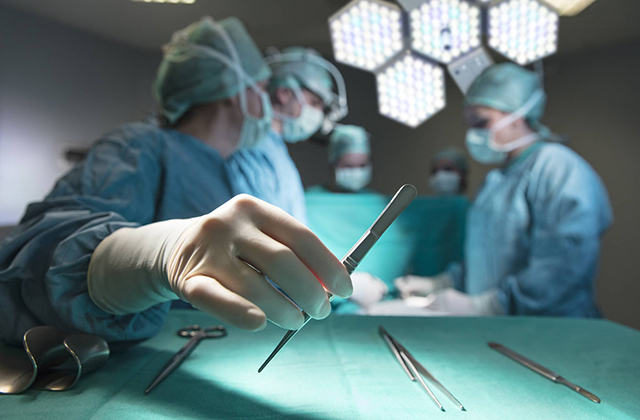This is an account of everything that happens, or may happen, during and around a surgical intervention and sometimes also when complicated examinations are performed.
When a child, a teenager or an adult have surgery, a long list of preparations are performed. During the surgery the bodily functions of the patient is supported and monitored by the means already prepared before the surgery as such. After the surgery the supporting measures are disconnected in a specific sequence.
All the measures are essentially the same for children and adults, but the psychological preparations will differ for different age groups and the supporting measures will sometimes be more numerous for children.
The following is a nearly complete listing of all measures undertaken by surgery and their typical sequence. All of the measures are not necessarily present during every surgery and there are also cultural differences in the routines from institution to institution and at diverse geographical regions. Therefore everything will not necessarily happen in exactly the same way at the place where you have surgery or perhaps work.
Greatest variation is perhaps to be found in the choice between general anesthesia and only regional or local anesthesia, especially for children.
INITIAL PREPARATIONS
There will always be some initial preparations, of which some often will take place in home before going to hospital.
For surgeries in the stomach area the digestive system often has to be totally empty and clean. This is achieved by instructing the patient to stop eating and only keep on drinking at least one day before surgery. The patient will also be instructed to take in some laxative solution that will loosen all stomach content and stimulate the intestines to expel the content effectively during toilet visits.
All patients will be instructed to stop eating and drinking some hours before surgery, also when a total stomach cleanse is not necessary, to avoid content in the stomach ventricle that can be regurgitated and cause breathing problems.
When the patient arrives in hospital a nurse will receive him and he will be instructed to shift to some kind of hospital dressing, which will typically be a gown and underpants, or a sort of pajama.
If the intestines have to be totally clean, the patient will often also get an enema in hospital. This can be given as one or more fillings of the colon through the rectal opening with expulsion at the toilet, or it can be given by repeated flushes through a tube with the patient in laying position.
Then the nurse will take measures of vitals like temperature, blood pressure and pulse rate. Especially children will often get a plaster with numbing medication at sites where intravenous lines will be inserted at a later stage.
Then the patient and also his family members will have a talk with the anesthetist that explains particularities of the coming procedure and performs a further examination to ensure that the patient is fit for surgery, like listening to the heart and lungs, palpating the stomach area, examining the throat and nose and asking about actual symptoms. The anesthetist may also ask the patient if he has certain wishes about the anesthesia and pain control.
The patient or his parents will often be asked to sign a consent for anesthesia and surgery. The legal requirements for explicit consent vary however between different societies. In some societies consent is assumed if objections are not stated at the initiative of the patient or the parents.
Technically most surgeries, except surgeries in the breast and a few others can be performed with the patient awake and only with regional or local anesthesia. Many hospitals have however a policy of using general anesthesia for most surgeries on adults and all surgeries on children. Some may have a general policy of local anesthesia for certain surgeries to keep down cost. Some will ask the patient which type of anesthesia he prefers and some will switch to another kind of anesthesia than that of the policy if the patient demands it.
When the anesthetist have signaled green light for the surgery to take place, the nurse will give the patient a premedication, typically a type of benzodiazepine like midazolam (versed). The premedication is usually administered as a fluid to drink. Children will sometimes get it as drops in the nose or as an injection through the anus.
The purpose of this medication is to make the patient calm and drowsy, to take away worries, to alleviate pain and hinder the patient from memorizing the preparations that follow. The repression of memory is seen as the most important aspect by many medical professionals, but this repression will never be totally effective so that blurred or confused memories can remain.
The patient, and especially children, will often get funny feelings by this premedication and will often say and do strange and funny things before he is so drowsy that he calms totally down. Then the patient is wheeled into a preparatory room where the induction of anesthesia takes place, or right into the operation room.
MEASURES PERFORMED RIGHT BEFORE ANESTHESIA
Before anesthesia is initiated the patient will be connected to several devices that will stay during surgery and some time after.
The patient will get a sensor at a finger tip or at a toe connected to a unit that will monitor the oxygen saturation in the blood (pulse oximeter) and a cuff around an arm or a leg to measure blood pressure. He will also get a syringe or a tube called intravenous line (IV) into a blood vessel, typically a vein in the arm. A couple of electrodes with wires are also placed at the chest or the shoulders to monitor his heart activity.
Before proceeding the anesthetist will once again check all the vitals of the patient to ensure that all parts of the body work in a way that allows the surgery to take place or to detect abnormalities that require special measures during surgery.
Right before the definite anesthesia the anesthetist may gives the patient a new dose of sedative medication, often propofol, through the IV line. This dose gives further relaxation, depresses memory, and often makes the patient totally unconscious already at this stage.
INDUCTION OF GENERAL ANESTHESIA
The anesthetist will start the general anesthesia by giving gas blended with oxygen through a mask. It can as an alternative be started with further medication through the intravenous syringe or through drippings into the rectum and then continued with gas.
Once the patient is dormant, we will always get gas blended with a high concentration of oxygen for some while to ensure a good oxygen saturation in the blood.
By many surgeries the staff wants the patient to be totally paralyzed so that he does not move any body parts. Then the anesthetist or a helper will give a dose of medication through the IV line that paralyzes all muscles in the body, including the respiration, except the heart.
Then the anesthetist will open up the mouth of the patient and insert a laryngeal tube through his mouth and past the vocal cords. There is a cuff around the end of the laryngeal tube that is inflated to keep it in place. The anesthetist will aid the insertion with a laryngoscope, an instrument with a probe that is inserted down the trout that enables him to look down into the airways and also guides the laryngeal tube during insertion.
Then the patient will be given artificial ventilation through the laryngeal tube that provides oxygen and anesthetic gas continually during the whole surgery process.
The traditional anesthetic gases were ordinary ether and chloroform. These are since long obsolete and nowadays one typically uses halogenated (mostly fluoridated) hydrocarbons and halogenated more complex ethers.
FURTHER PREPARATIONS
Then they will take all clothes off the patient so that he will be totally naked. More IV lines will now often be inserted into a vessel in the other arm, at his groin or at his thighs. A special IV line can also be screwed into the marrow in a bone at special occations. He will typically also get more electrodes to monitor the heart activity, for example at the thighs.
Often a tube called a Foley catheter is inserted through the urethral opening all the way into the bladder that then will drain the urine during surgery. At special occations a thin tube is inserted through the wall of the lower abdomen into the bladder instead, a so called supra-pubic catheter.
The patient ill often get a probe inserted to monitor the core body temperature during surgery. The probe can go in through the anus, or be pushed down his esophagus. Sometimes a Foley catheter with equipment for measurement of temperature is used instead.
Some surgeries require flushing or drainage of the intestines during and after surgery. Then a tube will be inserted through the anus and up into his colon for that purpose. Often also a tube is is inserted through the nose and down trough the esophagus into the stomach that will stay in place during and often after surgery. The tube is used to keep the stomach empty for secrets or for instillation of nutrients if the patient will not be able to eat for some time after surgery.
A big electrode will be placed onto the body of the patient, most often under the buttocks. This is necessary because the surgeon typically will use some kind of electric cutting tool, often called a harmonic knife, of which the cutting point will serve as the other electrode. Then the surgery site and a wide area around is painted with a solution of the yellow antiseptic agent betadine.
The nurses will lay the patient in the position necessary for surgery, which can be at back with straight kegs, at the side, at the stomach or at back with legs parted and flexed up, and many variations of these positions. The arms are often tied up above the shoulders of the patient or are held straight out from the body at special supports. Then all of the patient except the surgical site and the face is draped in blankets or other clothes.
LOCAL, REGIONAL SPINAL AND EPIDURAL ANESTHESIA
For some surgeries anesthesia comprising body parts are used instead of general anesthesia or in addition to general anesthesia to ease pain after surgery. When used as the main anesthesia, it will typically be administered early before many of the other preparations. When used as an additional aid, it will typically be administered late.
By local anesthesia an anesthetic drug is injected in the local area where the surgery takes place. It is typically used by very small surgeries.
By regional anesthesia one inserts a needle near to a nerve that serves a greater body part and injects an anesthetic so that this body part is numbed and lamed. Sometimes a thin catheter is also inserted through the needle. This will remain when the needle has been pulled out and anesthesia is then administered continually through that catheter afterwards.
Still another type of anesthesia used is so-called epidural anesthesia. By this technique the numbing medication is injected into the room where the spinal cord passes inside the vertebra, but over the dura mater and arachnoidea. These are two tissue sheets that surround the spinal cord. Also by this technique a thin catheter is often inserted through the needle that will remain when the needle has been pulled out to administer anesthesia continually.
A similar technique is spinal anesthesia. Here the medication is injected into the room between the arachnoidea and pia mater. The pia mater is the immediate dressing of the spinal cord. This anesthesia cannot be placed too high up on the back, because it can then hinder breathing and there is then also greater danger for injury to the spinal cord. It is typically used as main anesthesia at the lower part of the body.
Also when these methods are used as the main anesthetic mode, the patient will typically get some calming medication through an IV line in addition.
DURING SURGERY
Anesthesia will be furnished during the whole time of the surgery and body functions will be monitored. Neural activities may also be monitored to ensure that the anesthesia is effective. One may also perform neural tests to ensure that the surgery does not hurt nerves, which will require that the anesthesia is lessened a while.
It is a common belief based on history that the surgeon uses an ordinary knife and stops the bleeding with various kind of pinches. For parts of the work where very great precision is needed, knives are still used. To close great blood vessels, pinches are still the tool if needed. But for the most part he uses more modern cutting tools that also stop the bleeding at once.
The most common tool is a harmonic knife. This is a peak probe through which alternating current is sent into the tissue. The current warms up the tissue exactly at the point where the probe touches so that water boils in the tissue at that point, and the tissue splits apart. The alternating current also makes the blood coagulate. Another tool is a laser that warms up the tissue so that it splits apart and blood coagulates.
The surgeon can also use a coblation tool. This tool releases ions (electrically charged atoms) that have been energetically excited by an alternating voltage. The ions etch and dissolve tissue and the tool also sucks up the dissolved tissue. This kind of tool is mostly used where lumps of tissue shall be taken away, for example by tonsil surgery.
By orthopedic surgery where bone is cut, the surgeon will typically use tools like electric saws and drills and in many ways work just like a carpenter.
The traditional way of recomposing the tissue has been by needle and threads, which still may be used. But nowadays the surgeon often uses means like staples and glue also. By surgery in bone, screws are often used.
Modern surgery is often performed through tiny holes instead of large cuts. Through these holes, tubes called cannulas are placed. Through one of the cannulas a camera is inserted. Other cannulas are used to insert the tools for the work. The body cavity where the work is done is typically inflated by a gas. In the most modern settings, the whole battery of equipment is driven mechanically and is controlled from a computer unit where the surgeon sits. Such a setting is called robotic surgery.
AFTER SURGERY
After surgery the anesthesia is discontinued and the patient is allowed to wake up, but artificial ventilation continues some time during this process.
At this point the Foley catheter may be taken out in some cases, in others it will stay for hours or days after surgery. Many IVs and monitoring electrodes will be taken out, but at least one IV, the pulse oximeter, the blood pressure cuff and the electrodes at the breast area will be left to stay some time. Also catheters for administering of local anesthesia will be left to stay.
It is customary to place back the clothes on the patient at this point, at least at the lower body, which provides that the patient often will not know that he has been totally naked.
When the patient is nearly fully awake, the ventilation is discontinued and they take out the laryngeal tube. The patient will now typically begin breathing of his own. If that does not occur effectively at once, one will ventilate him with a mask until he is better awake.
When stable, the patient will be transferred to a post-operative bed unit where he will be monitored tightly for some hours. During hours and sometimes days after surgery the patient will typically be given medication to alleviate pain and nausea and for relaxation. Pain medication will typically be achieved with opiates. For sedation and nausea treatment they mostly use diazepines like midazolam. Then he will be transferred to an ordinary hospital rooms.
It is not good for the patient to only lay still long after surgery, because that can cause complications like blood clots. Therefore one tries to make the patient rise up some times as soon as possible. To avoid complications due to slow blood circulation, patients may be equipped with cuffs around the legs that are constantly inflated and deflated in a wave-like fashion.
At some point the rest of the IVs, the electrodes and the Foley catheter will be taken out and medication discontinued. Here’s what online doctor nowadays recommends before and after surgery.



